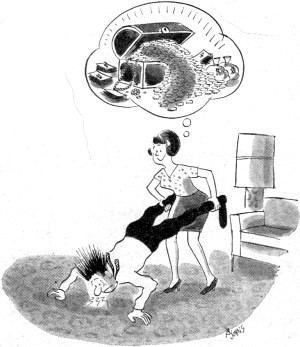Burning out Your Circuits Without Really Trying
|
|
Burning out Your Circuits Without Really Trying
The age of semiconductors brought with it the many advantages of subminiaturization, cool operation, and improved performance in everything from sophisticated FM tuners to electronic light dimmers. Diodes and transistors are not without problems, however; as I recently discovered. I made an excellent human treasure locator! I am an audio-visual enthusiast and take great pains to put on semi-professional slide shows for friends and relatives who visit us frequently. A Kodak Carousel projector is connected through a Sound Synchronizer to a transistorized tape deck and amplifier. The Synchronizer unit receives trip signals from one track of the stereo tape, in turn changing the slides in coordination with pre-recorded commentary and music. Colored lamps light the projection screen prior to the show's beginning; and by means of a light dimmer, the room lights and colored spots are slowly dimmed as the first slide comes on. Recently. in redecorating our family room, I made the mistake of having acrylic wall-to-wall carpeting put in. I was unaware of its highly electrostatic nature, particularly on cool winter evenings. Sparks can play havoc with apparatus containing semiconductors. When my wife or I walked across the room and then touched any metal surface, an intense spark was created. While not dangerous because of the infinitesimally low current, the voltage was probably near 100,000 volts with sparks as long as an inch and a half. We even found that we were able to locate metal surfaces behind the wall plaster (such as plumbing and conduits) by walking about and probing with a finger until a spark jumped into the wall. My wife insisted that perhaps there were treasures buried beneath the floor and asked that I crawl along the carpeting as a human treasure locator! In all seriousness, the electrostatic nature of acrylic was such that within a week I saw sparks fly into my FM tuner, lamp dimmer, and FM-AM clock radio. Each in turn suffered semiconductor damage, which was costly and emotionally disconcerting. At that point, I felt I would have to make a serious decision - sell the carpeting at a tremendous loss, or sell the semiconductor equipment at a loss of dollars and pleasure. I searched the catalogs and concluded that tube-type tuners and clock radios were rapidly becoming a thing of the past - what with their problems of size, heat dissipation, and lack of demand. My problems were finally resolved when I called in the firm which sold the carpeting. They recommended one of several available sprays, which, when applied, reduce the charge buildup on such fibers. Powders are. also available for the same purpose. They can be brushed into the rug, with the excess vacuumed up immediately. If you own or plan to buy transistorized radios, amplifiers, tuners, tape decks, light dimmers, or other appliances, make sure your carpeting is static-free.
Posted May 27, 2019 (original 9/12/2012) |
|


 By Errol J. Queen
By Errol J. Queen